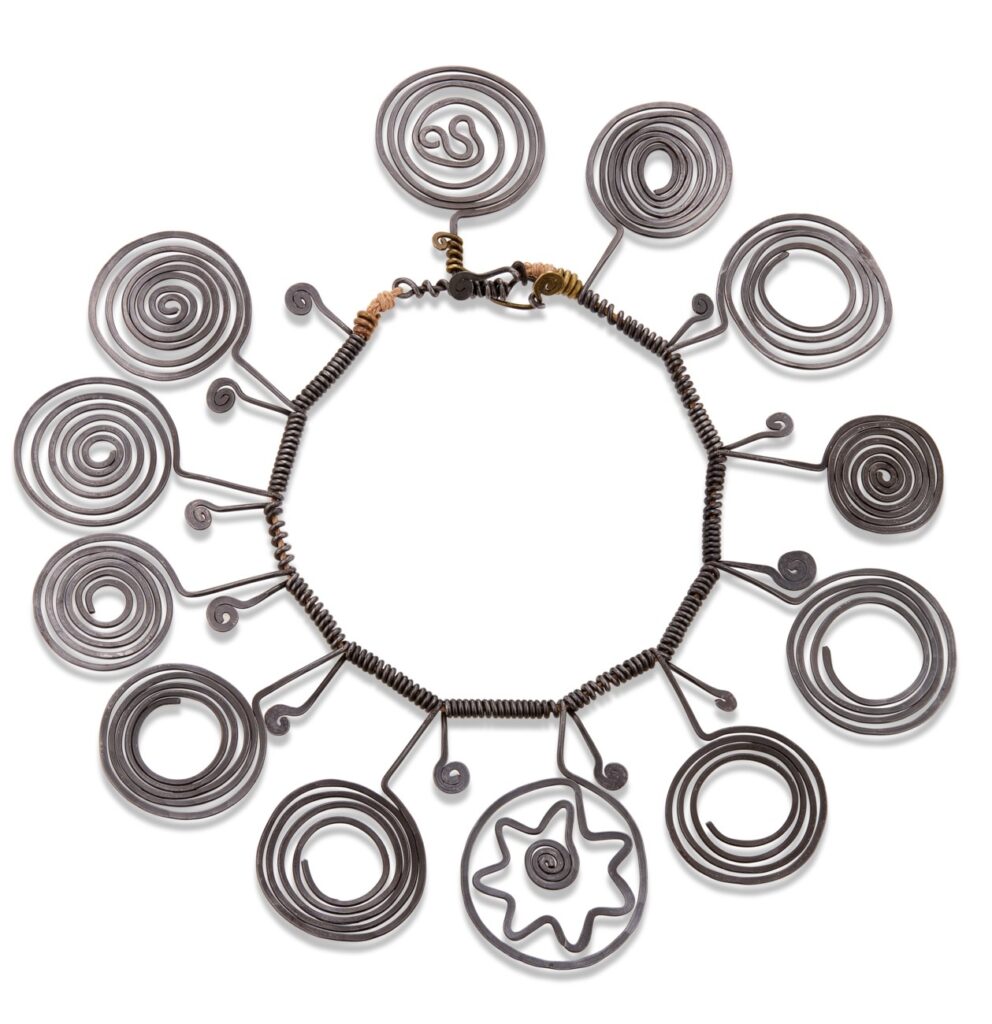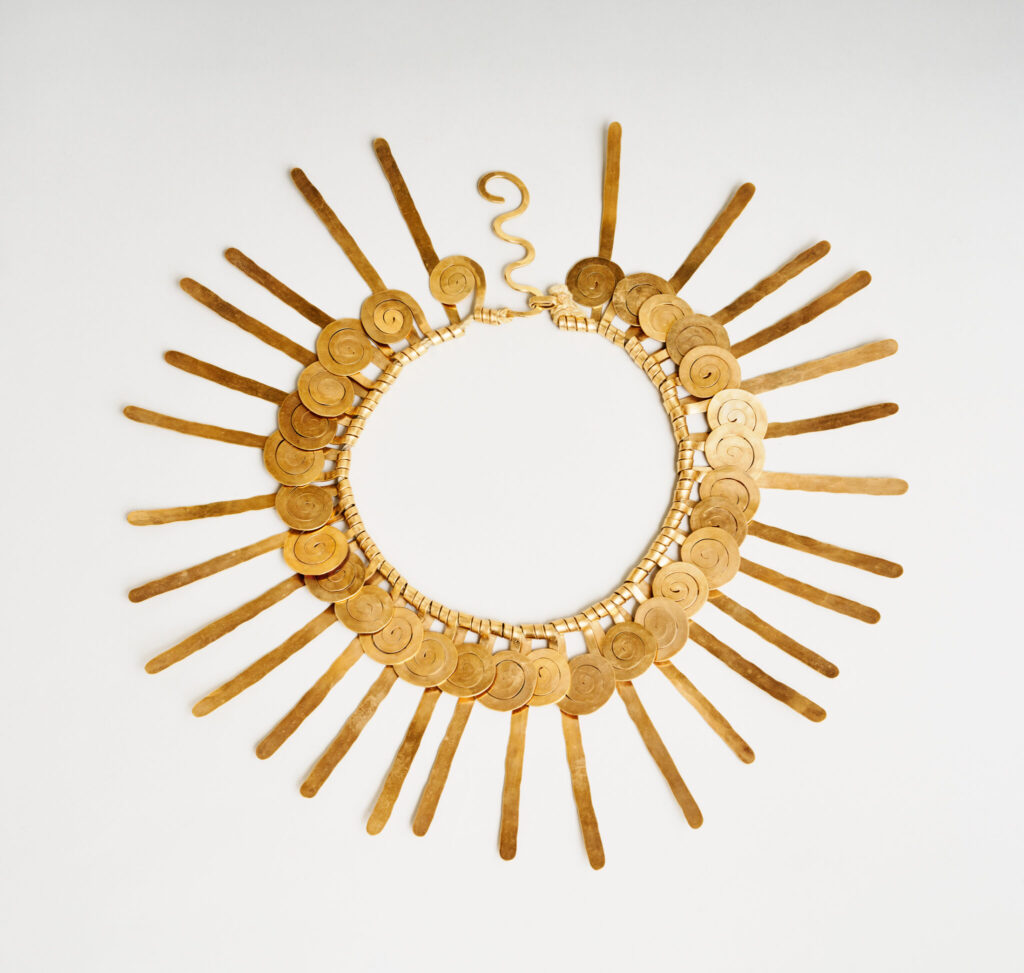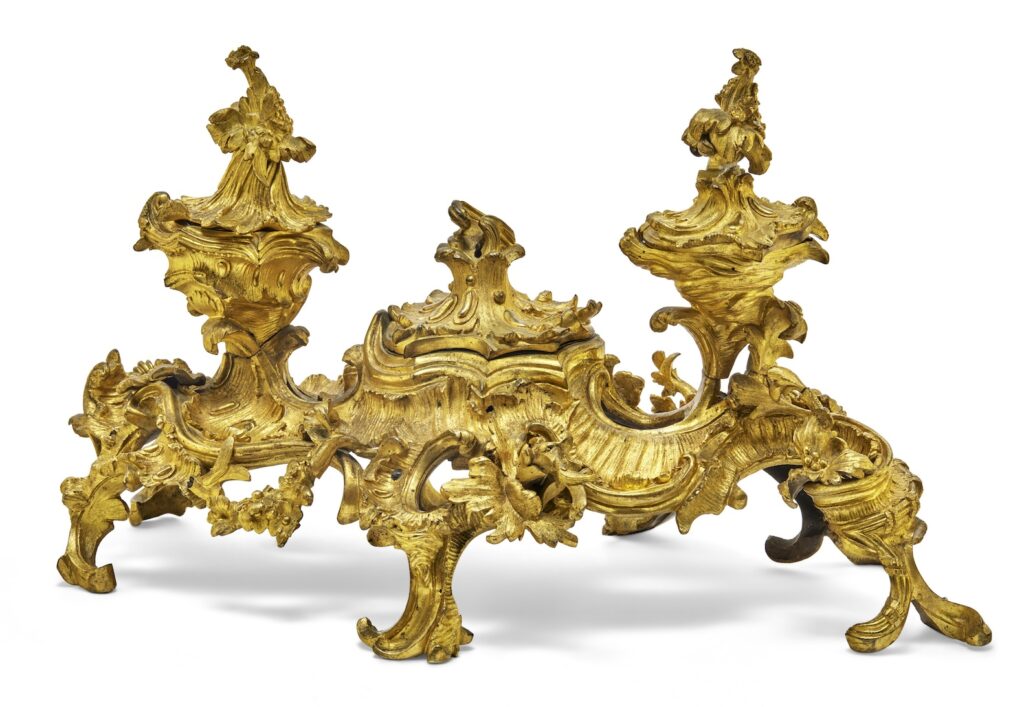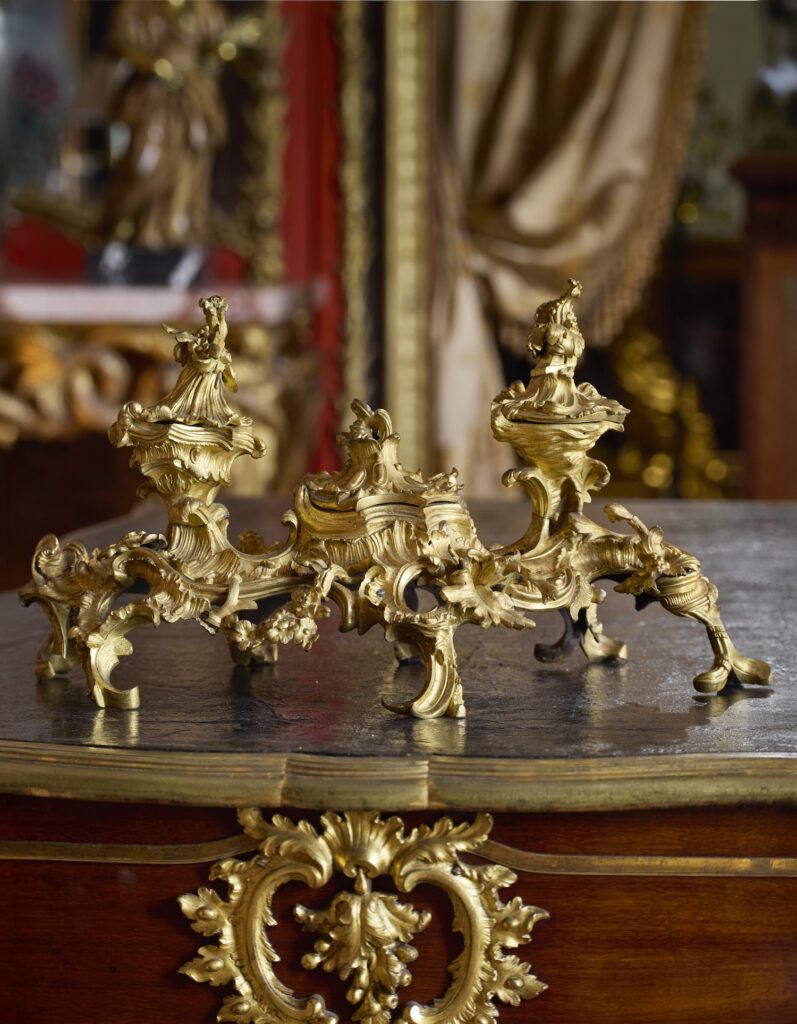
According to the Alexander Calder Foundation, there were 61 pieces of jewelry included in the artist’s first retrospective, Calder Mobiles, at the George Walter Vincent Smith Gallery in Springfield, Massachusetts, in November 1938. Was Encircled Star, 1938, among them? Christie’s doesn’t say. All they know is that Anne Bass bought it in 1972, when she was 31.

It is also not clear whether the similar necklace from 1937, in gold wire instead of steel, was not available, or if Bass figured steel was safer for wearing on the subway in the 70s.

And speaking of celebrated metalwork of the ruling class, this rocaille inkwell. Holy moley, how is this real? It has resulted in the following words, a kind of poetry, at once luxurious and terrible, which I reproduce here in French and translation:
ENCRIER D’ÉPOQUE LOUIS XV
VERS 1740
En bronze ciselé et doré, à décor de concrétions rocaille ajourées, feuilles d’acanthe, guirlandes de fleurs, joncs enrubannés, à trois encriers en partie supérieure sommés de fleurs et grenades éclatées ; un pied manquant [? -ed.]
LOUIS XV PERIOD INKWELL
CIRCA 1740
In chased and gilt bronze, decorated with openwork rocaille concretions, acanthus leaves, garlands of flowers, and ribboned rushes, with three inkwells in the upper part topped with flowers and burst pomegranates; one foot missing

Lot Essay
Cet exceptionnel encrier en bronze ciselé et doré, de forme mouvementée et asymétrique est caractéristique de la période Louis XV ou le style Rocaille est à son apogée. L’ensemble présente un agencement fluide de volutes, rocailles, coquilles et feuillages stylisés, porté par une base ajourée à quatre pieds cambrés, animés de motifs organiques en fort relief.
La composition très libre et inventive de cet encrier rappelle fortement le vocabulaire ornemental de Juste-Aurèle Meissonnier (1695-1750), ornemaniste du roi Louis XV, dont les dessins ont profondément influencé les arts décoratifs français du XVIIIe siècle. Le foisonnement décoratif, l’asymétrie assumée et le jeu de courbes et contre-courbes que l’on retrouve ici évoquent directement certaines planches gravées de Meissonnier, en particulier, la Planche 55 de son Neuvième Livre, conservée au Musée du Louvre, illustre un surtout de table aux formes tourmentées et aux ornements foisonnants, similaires à ceux de cet encrier (inv. L 417 LR/43 Recto ; vol.9, p.59).
De même, la Planche 115 de son œuvre, représentant un projet de surtout de table et de deux terrines exécutées pour le duc de Kingston en 1735, témoigne de l’inventivité et de la richesse ornementale que l’on retrouve dans notre pièce (inv. L 417 LR/109 Recto ; vol.9, p.59).
L’aspect extrêmement déchiqueté, presque baroque, des lignes et des ajours pourrait également suggérer une destination pour le marché germanique, particulièrement friand de compositions spectaculaires à la limite du fantastique. Le modèle des encriers en navette rocaille n’est pas s’en rappeler les bobèches du lustre de Jacques Caffiéri (1678–1755) conservé à la Wallace Collection à Londres (inv. F83).
Ce goût partagé entre la France et les principautés allemandes se retrouve chez des orfèvres actifs à Augsbourg ou Dresde, qui ont largement repris et diffusé les motifs inspirés de Meissonnier.
Ce type d’objet aurait ainsi pu séduire une clientèle impériale, attachée à une forme d’exubérance décorative à la fois raffinée et démonstrative.
This exceptional chiseled and gilded bronze inkwell, with its lively and asymmetrical shape, is characteristic of the Louis XV period, when the Rocaille style was at its height. The ensemble features a fluid arrangement of volutes, rocailles, shells, and stylized foliage, supported by an openwork base with four arched legs, enlivened with organic motifs in high relief.
The very free and inventive composition of this inkwell strongly recalls the ornamental vocabulary of Juste-Aurèle Meissonnier (1695-1750), ornemaniste to King Louis XV, whose designs profoundly influenced 18th-century French decorative arts. The decorative abundance, the assumed asymmetry, and the interplay of curves and counter-curves found here directly evoke certain engraved plates by Meissonnier. In particular, Plate 55 from his Ninth Book, preserved at the Louvre Museum, illustrates a table centrepiece with tormented shapes and abundant ornamentation, similar to those of this inkwell (inv. L 417 LR/43 Recto; vol. 9, p. 59).
Similarly, Plate 115 of his work, representing a design for a table centrepiece and two tureens executed for the Duke of Kingston in 1735, testifies to the inventiveness and ornamental richness found in our piece (inv. L 417 LR/109 Recto; vol. 9, p. 59). The extremely jagged, almost baroque, appearance of the lines and openwork could also suggest a destination for the German market, particularly fond of spectacular compositions bordering on the fantastic. The design of the rocaille shuttle inkwells is reminiscent of the bobeches of the chandelier by Jacques Caffiéri (1678–1755) held at the Wallace Collection in London (inv. F83).
This taste shared between France and the German principalities is also found among goldsmiths active in Augsburg and Dresden, who widely adopted and disseminated motifs inspired by Meissonnier.
This type of object could thus have appealed to an imperial clientele, attached to a form of decorative exuberance that was at once refined and demonstrative.
18 June 2025 Lot 139 | Alexander Calder, necklace, Est. $150-200,000 [christies]
19 Juin 2025 Lot 99 | Encrier d’Époque Louis XV, Est. EUR30-50,000 [christies]
Previously, related: The Second of 39 Louise Bourgeois Shackle Necklaces is For Sale
